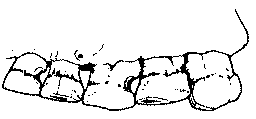 |
Science Frontiers ONLINE No. 61: Jan-Feb 1989 |
|
|
Interproximal Grooving Of Teeth
 The following illustration appeared recently in a respected science journal. No, it was not a dentistry journal, nor was it an
ad for a new toothpaste. It was Current Anthropology.
The following illustration appeared recently in a respected science journal. No, it was not a dentistry journal, nor was it an
ad for a new toothpaste. It was Current Anthropology.
It seems that some human and near-human skeletons possess teeth with the peculiar grooves shown in the sketch. The skeleton-age range is huge: 1.84 million years to comparatively modern bones 10,000 years old. These teeth are found on several continents. Some archeologists say simply that ancient humans just picked their teeth a lot in order to remove trapped food particles. But the grooves do not seem to be correlated with dental-decay problems. This fact has led to the so- called "cultural" theory, which holds that the picking of teeth was just another bad human habit, probably a sort of stereotype behavior having nothing to do with food caught between the teeth.
(Formicola, Vincenzo; "Interproximal Grooving of Teeth: Additional Evidence and Interpretation," Current Anthropology, 29:663, 1988. Also: Anonymous; "Ancient Tooth Grooves: Take Your Pick," Science News, 134:237, 1988.)
Comment. Could tooth-picking have been a religious rite? Are there cave drawings showing humans picking their teeth? Well, you can see from the Science News title that this publication also had fun with this item. Yet, the geographical and temporal reach of this phenomenon indicate that ancient humans were doing something rather strange for reasons we can only guess at.